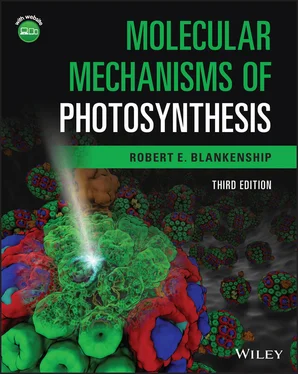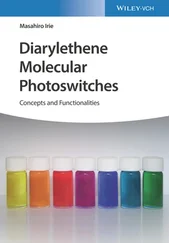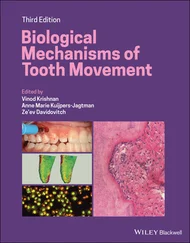Most purple phototrophic bacteria are capable of N 2fixation. In fact, certain classes of Rhizobia , the bacteria that live symbiotically in nodules of leguminous plants, contain bacteriochlorophyll and may actually use photosynthesis to supplement the energy requirements of nitrogen fixation (Fleischman and Kramer, 1998). Other Rhizobia do not express photosynthetic characteristics, but since they are proteobacteria, based on 16S rRNA analysis, they are therefore relatives of purple phototrophic bacteria.
2.5.2 Green sulfur bacteria
In contrast to the versatile purple bacteria, the green sulfur bacteria are metabolic specialists (Overmann, 2006). They are almost always obligate anoxygenic photoautotrophs, unable to grow with only organic carbon as a carbon source (Tang and Blankenship, 2010). The green sulfur bacteria do not fix carbon using the Calvin–Benson cycle; instead, they use the reverse tricarboxylic acid cycle to fix CO 2(Fuchs, 2011). They are also strict anaerobes, are incapable of any form of respiration, and are active nitrogen fixers. Green sulfur bacteria can be found in the anaerobic zone at the bottom of lakes or below the chemocline (the transition from aerobic to anaerobic conditions) in a stratified lake. These organisms preferentially utilize H 2S as an electron donor, which is abundant in these environments, although they can also use a variety of other donors such as thiosulfate or elemental sulfur (Frigaard and Dahl, 2009). The green sulfur bacteria can be found living in the lowest light intensities of any known phototrophic organisms (Beatty et al ., 2005; Overmann, 2006) and contain highly specialized antenna structures known as chlorosomes. These antenna complexes contain bacteriochlorophyll c , d , or e as principal pigments. The chlorosome is attached to the cytoplasmic side of the cell membrane, which does not invaginate as in purple bacteria. The green sulfur bacteria also contain bacteriochlorophyll a , which functions in both antennas and reaction centers and small amounts of chlorophyll a , which functions in reaction centers.
2.5.3 Filamentous anoxygenic phototrophs
The FAP, sometimes called the green nonsulfur bacteria (Hanada and Pierson, 2006), have metabolic characteristics that are very different from those of the green sulfur bacteria, and in most respects, the two groups of organisms are not closely related. This is in contrast to the purple sulfur and purple nonsulfur bacteria, which are very close relatives by comparison. The FAPs are the earliest branching group of bacterial phototrophs according to the 16S rRNA analysis discussed earlier. They are in most cases capable of photoautotrophic, photoheterotrophic, and aerobic respiratory growth. When grown aerobically, the FAPs suppress pigment synthesis and do not express the structural proteins involved in photosynthesis, similar to many purple bacteria. Most use a unique carbon fixation pathway known as the hydroxypropionate pathwayfor autotrophic growth (Fuchs, 2011), although they grow best by assimilating organic carbon during photoheterotrophic growth. The FAP bacteria contain bacteriochlorophyll a localized in reaction centers and integral membrane antenna complexes. These complexes are generally similar to those found in the purple bacteria. Most FAP bacteria also contain bacteriochlorophyll c , which is located in chlorosome antenna complexes that are generally similar to those found in green sulfur bacteria and is the major characteristic shared with them. The FAP bacteria are often found in microbial mats, where they live in association with cyanobacteria. They are especially widespread in thermophilic environments.
Surprisingly, a newly discovered anoxygenic bacterium that is a member of the FAP phylum contains a reaction center complex that is unlike the complex found in all other FAPs and is more similar to that found in the green sulfur bacteria (Tsuji et al ., 2020). This organism, Candidatus Chlorohelix allophototropha also appears to fix carbon using the Calvin–Benson cycle.
The heliobacteria are the third most recently discovered of the groups of anoxygenic phototrophs (Gest, 1994; Madigan, 2006). They are also the only group of phototrophs that belong to the Gram‐positive group of bacteria. Heliobacteria are the only group of phototrophic bacteria known to form endospores, a characteristic of many other Gram‐positive bacteria. They are strict anaerobes and are rapidly killed by exposure to oxygen. The heliobacteria do not appear to be capable of photoautotrophic growth and require organic carbon compounds such as pyruvate in the growth medium. They contain bacteriochlorophyll g as their main photopigment, and also small amounts of chlorophyll a . They are active N 2fixers and are often isolated from rice paddies, where they may make a contribution to the nitrogen economy of those environments.
By any measure, the heliobacteria have the least sophisticated photosynthetic metabolism of all known phototrophic bacteria. They have a homodimeric reaction center complex (discussed more in Chapters 6and 12) with very few protein subunits, no antenna complexes and no autotrophic carbon fixation pathway. They may be important in understanding the origin and early evolution of photosynthesis.
The chloracidobacteria are the second most recently discovered group of phototrophic bacteria, found in hot spring microbial mats (Bryant et al ., 2007). They have a homodimeric reaction center and chlorosome peripheral antenna complexes. They are aerobic organisms and are not capable of autotrophic carbon fixation. They contain bacteriochlorophyll a , c chlorophyll a , and small amounts of Zn bacteriochlorophyll a (Tsukatani et al ., 2012).
The most recently discovered group of phototrophic bacteria are the Gemmatimonadetes (Zeng et al ., 2014). These organisms contain bacteriochlorophyll a , are semiaerobic, and are incapable of assimilating inorganic carbon. Their photosynthetic apparatus is remarkably similar to that found in purple bacteria, and they have almost certainly acquired the ability to carry out photosynthesis by large‐scale horizontal gene transfer.
The cyanobacteria are a large and diverse group of photosynthetic prokaryotes (Bryant, 1994; Flores and Herrero, 2014). They are the only group of photosynthetic bacteria that have oxygenic metabolism, producing molecular oxygen as a byproduct of photosynthesis. Cyanobacteria were previously known as blue‐green algae, although this name is misleading as they are not true algae, which are all eukaryotes. As we will explore in more detail in later chapters, the mechanism of photosynthesis in cyanobacteria is remarkably similar to that in photosynthetic eukaryotes, which therefore makes study of them of special interest. Cyanobacteria are remarkably tough and resilient organisms that inhabit almost any environment where light is available, ranging from freshwater, marine, and terrestrial environments to extreme environments such as hot springs and even the surfaces and subsurface regions of rocks in both Antarctica and scorching hot deserts. Nearly all cyanobacteria are photoautotrophs, although some species can also grow photoheterotrophically. An electron micrograph of a representative cyanobacterium is shown in Fig. 2.4.
The cyanobacterial group includes all phototrophic bacteria that produce oxygen as a byproduct of photosynthesis. Most species contain chlorophyll a and phycobiliproteins, which function as antenna complexes. However, some types of oxygenic photosynthetic prokaryotes deviate from this pattern. These include the chlorophyll b ‐containing prochlorophytes and the chlorophyll d ‐containing organisms. Phylogenetic studies have shown that all these organisms form a single large phylum according to 16S rRNA (Flores and Herrero, 2014). This phylum is dominated by traditional cyanobacteria, so all prokaryotic oxygenic phototrophs are now usually called cyanobacteria for simplicity.
Читать дальше












